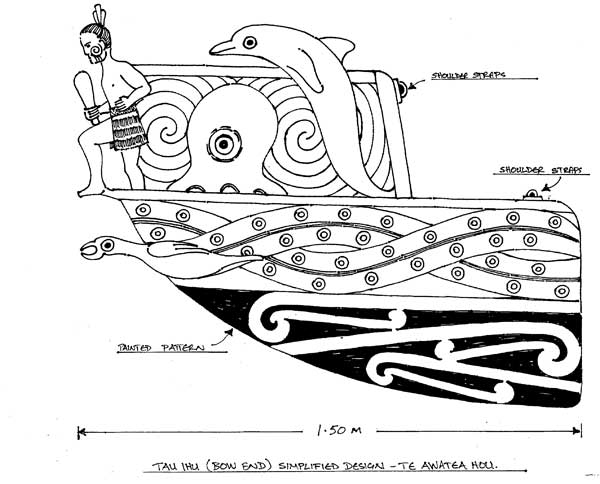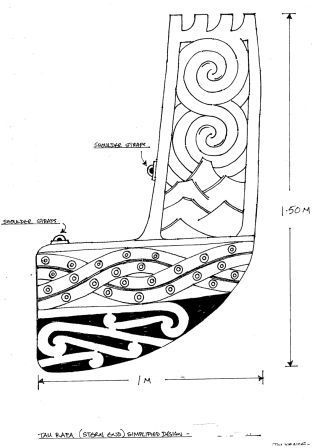Te Awatea Hou
In 1990 a Top of the South Island Waka Taua was built by Te Runanganui o Te Tau Ihu a Maui for the Waitangi Day celebration of New Zealand's 150 years.
Waitangi Day in 1990 was special, as it was the 150th anniversary of the signing of the Treaty of Waitangi. The largest gathering ever seen of Māori tribal war canoes (waka taua) at Waitangi was one of the centrepieces of the celebrations. This followed an ambitious national programme to build a fleet of ornately carved waka and assemble them at Waitangi as a demonstration of Māori pride and unity. The 22 strong fleet, powered by 1000 paddlers, also fulfilled a dream of Tainui leader Princess Te Puea Herangi that had been curtailed 50 years earlier by World War II.
A Top of the South Island Waka Taua was built by Te Runanganui o Te Tau Ihu o te waka a Māui (the confederation of the nine Marlborough and Nelson tribes) for the event. It was the sole representative from the South Island. This waka, Te Awatea Hou, no longer exists, apart from carvings held at the Nelson Provincial Museum, however a representation of the prow of Te Awatea Hou was made for the launch of the Prow website and for subsequent educational and cultural use in the community, by Karl Wulff of the Community Arts Workshop. The representation was made according to sketches by Tim Wraight, based on information about the original waka and the stories which it depicts in its carvings, provided by Marlin Elkington. Marlin has provided further detail about those stories, which reflect local pūrākau (legends and stories):
Te Tau Ihu (the prow or bow of the waka)
- The figurehead
The figurehead is Kupe. Kupe discovered Aotearoa c.900. - The Dolphin: Kaikaiawaro or Pelorus Jack
The Legendary mammal that used to escort vessels to and through French Pass. - Octopus or Wheke
Te Wheke-a-Muturangi was the pet octopus of Murutangi. Kupe had chased the octopus to Aotearoa. Kupe caught up with the octopus at Raukawa Moana, the Cook Strait region, and slayed it at the entrance to the Tory Channel. A rock just inside the entrance is called Whekenui Rock. At certain times of the year, red water flows through the Sounds. In Māori legends, this is the blood of the wheke. The eyes of the wheke are the Brothers Islands in the Cook Strait and the body drifted through to the Croisilles area.
The tentacles of Te Wheke-a-Muturangi travel the length of the waka from te tau ihu (the prow) to te taurapa (the stern). This symbolises the wheke's embrace of the waka, providing a sense of security, that Te Awatea Hou is able to go anywhere at any time with a full understanding that its occupants are safe and secure. - The shag: Te kauwau-a-toru
This shag was a pet of Toru (one of Kupe's daughters). The shag's role was to test the waterways and currents for Kupe.
The waters which were first tested were the Pandora Bank, Northwest of Ninety Mile Beach. The second was Te Moana-a-Raukawa (Cook Strait). Whilst here, the shag heard of the area called French Pass and was warned by the local birds not to test the current at its full flow. However, the shag saw its role as having to give a full and complete report back to Kupe and the only way that the shag could achieve this, was to test the currents at their full flow. Because the current of the tide was so strong, when the shag dipped down to test the water with his wing, his wing snapped and broke. The shag's wing is now seen as the reef in the French Pass area.
Taurapa (Stern)
- Figurehead
The figurehead is Hui Te Rangiora, C.700. He was the first great navigator to arrive in Aotearoa, and the first recorded human being to enter the South Pole, Antarctic territory. Because of this, Hui te Rangiora is on the Taurapa, and the great navigator that followed him 200 years later, Kupe, on the Tau ihu. - Ngā Hau e Whā
Four fingers are situated at the top of the Taurapa representing the four winds, Ngā Hau e Whā, indicate all the people from all points of the compass. - Aoraki (Mount Cook)
The mountains depict the Southern Alps. - Puhi Puhi
The four shorter strands represent Ngā Hau e Whā, and indicate the effect of the wind direction on the waka. The three long strands indicate the flow of the current. - Hoe
The paddle. Kaihoe is the paddler.
The life of Te Awatea Hou - a timeline
-
20 January Launch of the 20-tonne, 30 m waka taua, which was constructed at Woodbourne air base
-
28 January Journey to the Treaty of Waitangi celebrations. It took part in these celebrations with 21 other Waka Taua and as the sole representative from the South Island
-
8 February The waka returned to Waikawa Bay
-
13 February Queen Elizabeth II visits Waikawa Marae
-
16 February Nineteen hour crossing of Cook Strait to Porirua
-
24 February The Waka Taua becomes Waka Tangata. 185 wahine, from as far afield as Christchurch, participate in the maiden voyage
-
8 March The waka leaves Waikawa Bay for Nelson via French Pass, arriving 10/03/90 after a 42 hour journey.
-
June Children from Waikawa schools are taken for their first waka cruise
-
17 June Commemoration day for the signing of the Treaty of Waitangi at Horahora Kakahu island in Port Underwood
-
2 November Kaiapoi River Carnival
-
01 December On display at Motueka Agricultural and Pastoral Association Show
-
02 December On display at Woodbourne air base
-
09 December On display at Carols by Candlelight by the Taylor River in Blenheim
-
31 December Journey to Twizel to mark the closing 1990 celebrations
1991
- 24 January First anniversary and relaunching of Te Awatea Hou
-
26 February To Ship Cove for use with 140 at risk teenagers
-
08 November Left Waikawa Bay for Wellington. A fast 10 hour crossing of the Cook Strait followed the Tainui tribute.
-
09 November-15 January
Tainui tribute - a circumnavigation of most of the North Island, following the legendary route taken by the canoe Tainui (carried across land between the Waitemata and Manukau harbours in Auckland).
1992
-
15 January The waka returns to Waikawa Bay
-
Feb. 1992 Waka taken to Takaka for Queen Beatrice of the Netherlands' visit marking the 300th anniversary of Abel Tasman's discovery of New Zealand.
-
Feb. 1992 To Havelock through the Pelorus Sounds
-
April 1992 To Australia for the Melbourne Māori Festival
1993-
-
March 1993 Fundraising in Nelson for Whakatū Marae Flats and the Nelson coastguard
-
June 1993 Waka involved in filming a BBC documentary: Nomads of the Winds
-
Jan. 1994 Vandals decapitate the carved figure of Kupe on the bow and cut the waka loose from its moorings in Waikawa Bay.
-
Sept. 1998 Waka arrives in Nelson for the first time in eight years to take part in the Kaupapa Māori Arts Festival and Cultural Tourism Symposium.
-
2 Oct. 1998 Te Awatea capsizes and breaks up in heavy seas off Cape Soucis. It flipped after a tow rope of the fishing boat, which was taking it from Nelson to Picton, frayed and the waka's engine ran out of fuel. The pieces were salvaged at Okiwi Bay.
Story by: Marlin Elkington
Further Sources
Books
- Nelson, A. (1991) Nga waka Maori. Auckland: MacMillan, pp. 91-92 [includes picture of Te Awatea Hou arriving in Titahi By during double crossing of Raukawa, 1990]
http://www.worldcat.org/oclc/27053682
Newspapers
About Te Awatea Hou
[Where no hyperlink is supplied ask at your local library about full text access to the articles.]
- Distinguished eight years (1998, October 6) The Nelson Mail, p.2
- Distinguished eight years (1998, October 6) The Nelson Mail, p.2
- Epic voyage - Waka Tangata, Te Awatea Hou - visits Whanganui (1992, Feb.) Mana Tangata : Maori Newspaper, p.41,4
- Frayed tow rope led to waka capsize (1999, February 6) The Nelson Mail, p.3
- Local waka damaged, may have broken up (1998, October 5) The Nelson Mail, p.1
- Marae on the water (1998, September 21) The Nelson Mail, p.10
- No details released about waka's last hours (1998, October 6) The Nelson Mail, p.1
- O'Connor, Tom (1993 May/June) New tourist venture ahoy for waka tangata Kia Hiwa Ra : National Maori Newspaper, p.1234
- Smith, Mike (1991, June) Cook Strait by waka. Service, 4(2), p.22-23
- Tainui Games Kawhia 1992 : an epic journey into history (1993 August/ Sept.) Kia Ora News,; p.1(6)12-13
- Waka double crossing a dream come true (1990, February 19) Evening Post, p. 3
- Waka flipped after towing and fuel problems (1999, February 8) The Press, p.8
- Whititera (1993 June/July) Tainui Games Kawhia 1992 : an epic journey into history. Kia Ora News, p.1(5)13
About the 1990 Waitangi day waka celebrations:
- Mikaere, Buddy (1990) Year of the waka. New Zealand Geographic, 5, p.8-29
- Waka (2000, March/April) Pu Kaea, p.17,22
- Waka taua (1989, July) Te Iwi o Aotearoa, p.2311
Maps
- Waka: the awakening dream (1990). [Documentary]. New Zealand: Nimrod Film Productions [Documentary film of the 1990 waka celebration at Waitangi]. Available to view on NZOnScreen:
https://www.nzonscreen.com/title/waka-the-awakening-dream-1990
The Nelson Provincial Museum holds:
- The prow of the Te Awatea Hou - restored and on display
- Film clips of the waka

